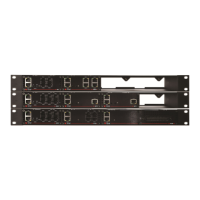QX50/QX200/QX2000; (SW Version 6.0.x) 74
QX50/QX200/QX2000 Manual II: Administrator’s Guide
FXS Lines
FXS (On-board) Line Settings
The FXS (On-board) Line Settings page is used to configure QX lines and to define the caller ID detection type, configure remote party disconnect
indication and select the ringer type on each of them. Additionally this page provides an option to enable Loopback diagnostics on the lines.
Onboard Line Settings
Available
Lines
where all active lines of QX IP PBX are listed with their
Attached
Extension. If the line is attached to an extension, the corresponding
extension number is displayed in this column; otherwise “none” is
displayed if the extension is not attached to the line. By clicking on
the extension number, the
Extensions Management - General Settings
page will appear, where the line attached to the extension can be
reconfigured. Additionally, the table provides information about the
selected Ringer Type and Caller ID detection method that is
configured for the selected line. The caller ID detection method is
different for various types of phones and can be found in the phone
manual.
Fig.II- 107: FXS Lines Page
When pressing on the line number under the Available Lines column, the FXS (On-board) Line Settings page specific for the current line is opened and
offers the following input options:
Caller ID
drop down list contains various standards of Caller ID
transmissions. It is used to send the calling party's information to the
phone attached to the selected line:
• No Caller ID.
• FSK, send prior to the first ring.
• FSK, send between the first and second ring.
• FSK, send both prior to a ring and between the first and second
ring.
• DTMF, send prior to the first ring.
• DTMF, send between the first and the second ring.
• Combined, send both DTMF prior to the first ring and FSK
between the first and the second rings.
The QX IP PBX sends the current time/date to the called phone
together with the caller’s information.
Fig.II- 108: FXS Line Settings page
A group of Remote Party Disconnect Indication parameters are used to configure the private PBX attached to the QX IP PBX FXS port.
• The Enable Busy Tone Indication checkbox enables a busy tone transmission to the FXS port when the remote party being called is disconnected.
The Busy Tone Duration drop down list is used to select the period (in seconds) when a busy tone will be transmitted to the FXS port.
• The Enable Power Disconnect Indication checkbox enables the power cycling on the FXS line when the remote party being called is
disconnected. Power Disconnect is applied after the busy tone transmission on the FXS line. The Disconnect Duration drop down list is used to
select the period (in milliseconds) when the FXS line power will be down.
The Ringer Type drop down list allows you to select the frequency of the ringer supported by the phone attached to the line. Information can be found on
the phone enclosure or in the phone's manual. Problems with the ringer might occur if the ringer type selected here does not correspond to the one
supported by the phone.
Please Note: The supported ringer type can be found on the bottom of the phone, in the “Ren:x.xN” value where N is the ringer type supported by the
phone. For example, if N=A, the TypeA ringer type should be selected, if N=B, the TypeB&Z ringer type should be selected.
The Enable off-hook Caller ID checkbox enables Caller ID transmission to the phone in the off-hook state attached to a certain line. Service is applicable
to the phones supporting the Call Waiting Caller ID feature.
The Enable Hot Desking Capability checkbox is used to enable the
Hot Desking feature on the corresponding onboard analogue FXS line.
Please Note: When this option is enabled or the analogue FXS lines are attached to the corresponding extension, the caller gets dial tone. Otherwise there
will be no dial tone for FXS lines.
The Hot Desking Automatic Logout section is used to configure Hot Desking functionality expiration on the corresponding FXS line. This may be useful
when someone who logged in to the public phone with the extension attached to this line forgot to log out after using it. With this option enabled, once the
expiration time arrives, the extension will automatically log out from the public phone.





